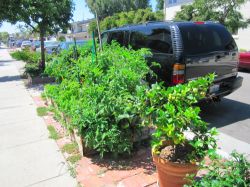 I came across an interesting little book a few weeks ago called Public Produce, authored by Darrin Nordahl. The book discusses the urban agriculture movement and highlights several programs in both California and Iowa – two states the author has called home (and I have also called home).
I came across an interesting little book a few weeks ago called Public Produce, authored by Darrin Nordahl. The book discusses the urban agriculture movement and highlights several programs in both California and Iowa – two states the author has called home (and I have also called home).
The move to public produce has been driven in part by several issues: energy security, food security and the rising cost of food. The author notes how intricately all three of these issues are tied together – higher price of energy means higher price of food.
But what he really focuses on are the future options to grow our food in light of a backlash against production agriculture. “Now, as the twenty-first century is underway, a cresting wave is readying the backlash against large-scale corporate agriculture on fields hundreds–if not thousands–of miles from where we live, against mass-produced, chemically grown produce; against the rising costs of food and the declining health of the American people.”
He then notes that the “buy-local” movement is leading the way for the “slow-food” movement, which Nordahl says seems to be the choice of the future.
One component of the slow-food movement, which is focused on in this book, is that of public produce. This can be in the form of community gardens or even community food growing along public sidewalks. The idea, is that this food is free and gives people of all economic status, especially the poor who have less access to fresh fruit and vegetables, access to fresh foods.
 But this is a new way of thinking that many people, especially city governments, are slow to adopt. Most cities don’t allow fruit trees to be grown along a sidewalk due to the clean-up required of fallen fruit (and the litigious nature of our society). And, you have to deal with people who take more than their fair share.
But this is a new way of thinking that many people, especially city governments, are slow to adopt. Most cities don’t allow fruit trees to be grown along a sidewalk due to the clean-up required of fallen fruit (and the litigious nature of our society). And, you have to deal with people who take more than their fair share.
Another option discussed is to create an edible garden (either front or back yard) that incorporates fruit and vegetables into your landscape. The majority of the spoils would go to the homeowner, but he or she would have the option of giving the extra food to their neighbors or members of their community.
While I see the the concept of public produce and edible gardens a good one, I don’t believe that this concept will work well in cold areas (you’d only have public produce in the summer and fall) and, I don’t believe you can grow enough food in your backyard or along the sidewalk in city spaces, to feed the masses. It will take all forms of food production to feed us in the future.
Despite the drawbacks, if you are interested in the concept of public produce and how to start a program in your community, then this book is a good start.
